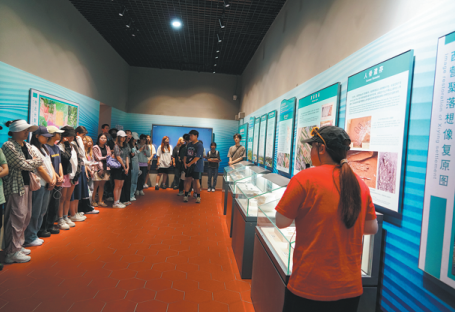Past undeniable proof of cross-Strait bonds
Taiwan leader twists historical facts in attempt to mislead island's inhabitants

Editor's note: The Taiwan question is a key focus for China and the international community. China Daily is publishing a series of reports to track hot Taiwan-related topics and address disinformation from the Democratic Progressive Party administration.
Archaeological evidence confirms a long history of human movement from the southeastern coast of the Chinese mainland to the island of Taiwan, dating back to prehistoric times when a shallow strait that was once land facilitated crossings tens of thousands of years ago.
Taiwan leader Lai Ching-te's recent assertion that Taiwan has had an "independent ecological system" since ancient times and is the birthplace of Austronesian culture has been met with skepticism from historians, accusing him of attempting to sever the deep historical and cultural ties between the two sides of the Strait.
During the last glacial period about several tens of thousands of years ago, Taiwan was connected to the Chinese mainland by a land bridge due to lower sea levels and a cooler climate, enabling the passage of animals and early humans.
Chen Zhongchun, director of the Institute of History at the Graduate Institute for Taiwan Studies of Xiamen University, said that DNA analyses of archaeological remains found in coastal areas of Fujian province and Taiwan indicate a shared origin, with the former dating back further in time.
Fossils of ancient land animals such as rhinoceroses and elephants have been found on the Dongshan Land Bridge that connected the coastal regions of Fujian and Taiwan, Chen said.
"Early human migration, driven by the pursuit of food sources, likely led them to track these animals all the way to Taiwan," he said, adding that it indicated that there was connectivity between the two sides during ancient times.
Passage between two sides
As temperatures rose from the Holocene period about 12,000 years ago, the Taiwan Strait formed, but exchanges between the two regions persisted. Advanced maritime skills were evident in archaeological finds in Fujian and Zhejiang provinces, such as dugout canoes, showcasing the seafaring abilities of ancient humans and their diverse methods for crossing between the mainland and Taiwan.
Fan Xuechun, director of the Pingtan International Institute of Austronesian Research, said that Austronesian people began spreading from the mainland coast approximately 6,000 years ago when sea levels were relatively high.
Descendants of the Austronesian language family, totaling more than 400 million individuals, reside on various islands, including ethnic groups in Taiwan, according to Fan.
The origin of the Austronesian people has been traced back through DNA analysis to Fujian. Pingtan, an island on the western side of the Taiwan Strait, served as their initial step toward the Pacific Ocean, he said.
The Keqiutou Site in Pingtan, dating back 6,500 to 5,500 years, has revealed a society adept at hunting and fishing, with relics like stone tools, pottery, and a diverse array of terrestrial and marine animal remains.
"They settled on Pingtan Island for a long time, establishing primitive villages and mastering advanced navigation techniques. Due to population growth, they sought space elsewhere, so they crossed the Strait and first arrived in Taiwan," Fan said.
Archaeological discoveries in Taiwan demonstrate a rich cultural exchange involving groups moving from the mainland. The Keqiutou site shares similarities with the Dabenkeng culture of Taiwan, indicating cultural diffusion from the mainland to Taiwan.
"There is a shared aesthetic among prehistoric inhabitants, such as shell-edged pottery and nail-impressed designs, indicating cultural diffusion from the mainland to Taiwan," he said.
Around 5,000 years ago, Austronesian people further expanded to the Philippines. Subsequently, they split into two groups, with one spreading to the South Pacific and the other propagating toward the Indian Ocean. Eventually, around a thousand years ago, they reached New Zealand in the South Pacific and Madagascar in the Indian Ocean. The international academic community views their migration as one of the most significant maritime migrations in human history, predating Columbus' discovery of the New World.
Since 2017, the Pingtan Austronesian sites, including a museum, have welcomed nearly 100,000 visitors from abroad, including over 5,000 visitors from Taiwan, aiming to promote exchanges.
More communication
Experts have also criticized Lai for deliberately overlooking the enduring administrative governance of Taiwan by successive Chinese authorities that led to continuous migration to develop the island.
The earliest historical references for the Chinese development of Taiwan date back to the Seaboard Geographic Gazetteer compiled in the year 230 by Shen Ying of the State of Wu during the Three Kingdoms period (220-280).
From the Song (960-1279) and Yuan (1271-1368) dynasties onward, successive Chinese central governments established administrative control over the island. In 1885, the Qing Dynasty (1644-1911) officially designated Taiwan as a province, marking it as the 20th province of China.
Approximately 80 percent of Taiwan's population can trace their lineage back to Fujian, reflecting the historical trend of significant population movements to the island.
Chi Chia-lin, the honorary chairman of the Reunification Alliance Party in Taiwan, criticized Lai for overlooking the Qing government's governance of Taiwan, which effectively managed relationships between ethnic groups.
The governance by the Qing government facilitated a substantial migration of Han people from southern Fujian and Guangdong provinces, nurturing the close ancestral ties between Taiwan and the mainland, Chi said.
Looking back 80 years to World War II, historical documents such as the Cairo Declaration and the Potsdam Declaration laid the foundation for Taiwan's return to China, restoring historical justice and a post-war international order, he said.
"At that time, Taiwan compatriots on the island were engulfed in ecstatic celebrations," he said. "Taiwan is definitely China's territory."
Hsiao Hsu-tsen, executive director of the Taiwan-based Ma Ying-jeou Culture and Education Foundation, said Lai's assertion that Taiwan is not part of China contradicts historical facts and fails to persuade the Taiwan people.
"Taiwan and the Chinese mainland absolutely are not two countries, but one country," Hsiao said. "Not to mention our shared history and culture. People in Taiwan worship Mazu and Guan Gong every day, and they both originated from the mainland."
Reflecting on recent student exchanges to Fujian, Hsiao observed the seamless adaptation of Taiwan students to Fujian's cuisine, dialects and customs, underscoring the unbreakable connections.
Chi said that Lai, through a series of speeches, has engaged in ideological manipulation of the Taiwan public toward separation, aiming at cutting off the legal and historical connection between the two sides.
Lai delivered a speech on June 22, claiming the island is "a country", which was the first of 10 speeches planned as part of a tour aimed at "uniting the country" ahead of public votes on July 26 regarding the recall of opposition lawmakers.
"These moves further tear apart people's identity in Taiwan, and accelerate the rift between the two sides of the Strait," he said, adding that Lai's peddling of cross-Strait conflicts and hatred toward the mainland might place the island in a serious situation.
Chen Binhua, a spokesman for the State Council Taiwan Affairs Office, condemned Lai's speeches as laden with falsehoods, hostility and provocation, saying that his fallacies will "ultimately be swept into the dustbin of history".



Today's Top News
- Xi sends congratulatory letter to Global Civilizations Dialogue Ministerial Meeting
- China harvests 149m tons of summer grain
- 38 new mineral deposits discovered in China this year
- There is no alternative to multilateralism
- Beijing ready to face US trade arrows
- Strategic autonomy of vital importance to EU






























